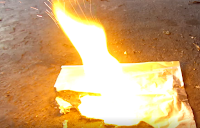Nitrostarch is easily prepared by the mixed acid nitration of starch. Normally a mixture of nitric and sulphuric acids is used, but I chose to use potassium nitrate and sulphuric acid which forms nitric acid in situ.
To begin, I poured 36ml of 98% sulphuric acid into a 250ml beaker in an ice bath. Once the temperature of the acid had dropped below 10 C, I began adding 11.2g of potassium nitrate in small portions with good stirring. During the additions, the temperature was never allowed to rise above 20 C. Once all the potassium nitrate had been added, I added 10g of corn starch to the mixture in one portion with good stirring. The mixture became quite viscous and turned slightly yellow. I stirred the mixture continuously for 15 minutes, then left it to stand for 2 hours with occasional stirring, maintaining the temperature at below 10 C. After this, I began cautiously adding 400ml of water to the reaction mixture. Once a small amount of water had been added, the mixture became fluid enough to be easily poured, so I transferred the mixture to a 1000ml flask before adding the rest of the water. I left the mixture to stand until all the nitrostarch had settled to the bottom of the flask, then decanted and discarded as much of the cloudy supernatant liquid as I could without losing any nitrostarch. I then added a further 400ml of water to the nitrostarch and repeat the above process (letting then nitrostarch settle then decanting as much of the supernatant liquid as possible).
Again, I added 400ml of water to the nitrostarch that was left but this time also added in 3ml of 100% undiluted nitric acid. I boiled the mixture for 10 minutes with good stirring, covering the top of the flask to help prevent loss of the volatile nitric acid. Still heating, I then neutralized the mixture with sodium bicarbonate until the liquid became neutral-slightly alkaline. By mistake I sometimes added a bit to much bicarbonate and the mixture bubbled over a couple off times. I think this may have led to fairly substantial loss of product. Anyway, after the neutralization, I filtered off the nitrostarch, washing it on the filter with 1000ml of water. After drying, I was left with 2.62g of nitrostarch as a white powder with a slight yellow colour.
Left = nitrostarch / Right = deflagration of nitrostarch
KNO3 + H2SO4 ==> KHSO4 + HNO3
HNO3 + 2 H2SO4 <==> 2 HSO4 (-) + NO2 (+) + H3O (+)
Again, I added 400ml of water to the nitrostarch that was left but this time also added in 3ml of 100% undiluted nitric acid. I boiled the mixture for 10 minutes with good stirring, covering the top of the flask to help prevent loss of the volatile nitric acid. Still heating, I then neutralized the mixture with sodium bicarbonate until the liquid became neutral-slightly alkaline. By mistake I sometimes added a bit to much bicarbonate and the mixture bubbled over a couple off times. I think this may have led to fairly substantial loss of product. Anyway, after the neutralization, I filtered off the nitrostarch, washing it on the filter with 1000ml of water. After drying, I was left with 2.62g of nitrostarch as a white powder with a slight yellow colour.
Left = nitrostarch / Right = deflagration of nitrostarch
KNO3 + H2SO4 ==> KHSO4 + HNO3
HNO3 + 2 H2SO4 <==> 2 HSO4 (-) + NO2 (+) + H3O (+)


No comments:
Post a Comment